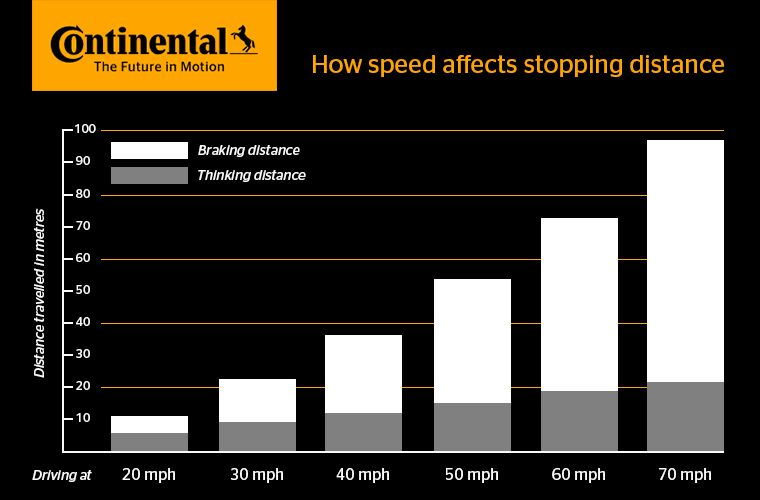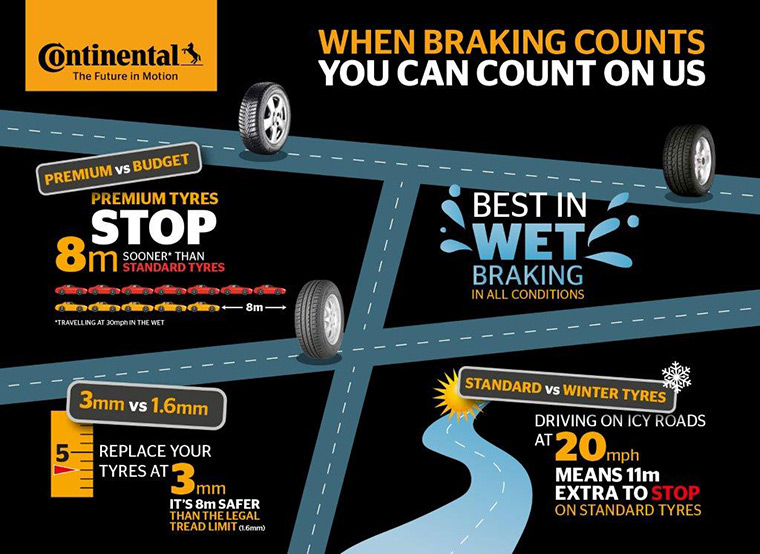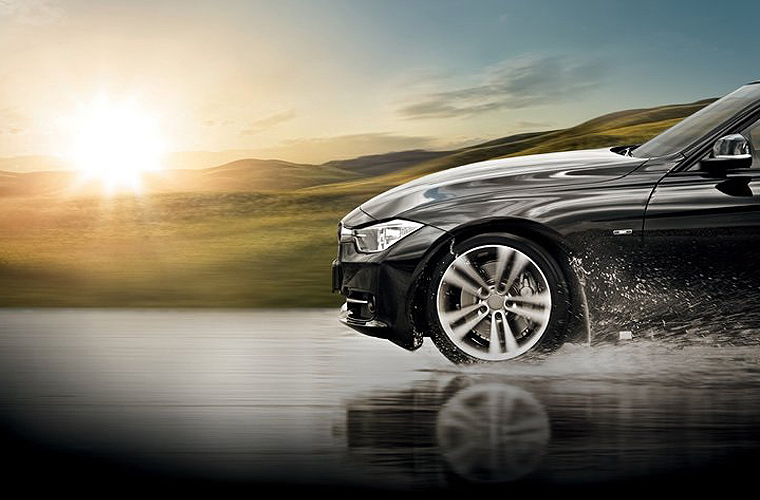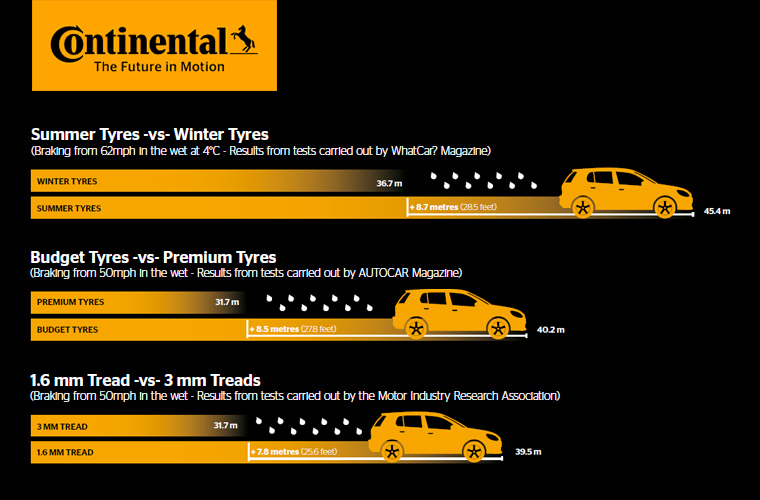At Asda Tyres, it matters to us that – when it comes to tyres and driver safety – you’re as informed as you possibly can be. Regular readers of our tyre safety advice may already be familiar with ‘stopping distances’, but if you’re not, it’s worthwhile taking a moment to fully understand their importance, and how your tyres – as well as the prevailing climate – determine the length of this distance.
Think you know what stopping distance is? Not everyone actually does…
Some drivers believe that that stopping distance is the length a car travels from the moment the brakes are applied, to when it finally comes to a complete stop. They’re wrong. This length is actually ‘braking distance’, and – while certainly a large component of overall stopping distance – not the only one that needs consideration. In fact, before this value even becomes a factor, there’s an equally important component – the ‘thinking distance’.
Sound familiar? It would have been covered in driving lessons, which for some may have been a very long time ago, and hence forgotten. Thinking distance is the length of road travelled before realising there’s a need to brake, and then react. This time can seem relatively short – perhaps just a second, or two – but can result in a car travelling – in relation to the circumstances of needing to brake – a very long distance.
Remember: Your stopping distance equates to thinking distance plus braking distance.
A driver’s thinking distance can be influenced by a vehicle’s speed, the clearness – or otherwise – of their visibility, tiredness, sobriety, and distractions. It’s therefore reasonable to say that a sober, alert, undistracted driver with clear visibility will probably have quicker reaction times than someone who is weary, distracted, and under the influence of alcohol or drugs, while driving in rainy conditions.
Braking distance is influenced by vehicle speed, the weather, and tyres (including their condition, type and quality). It goes without saying that travelling at high speed – particularly in poor driving weather – will typically require a longer braking distance to come to a stop, compared to that of slower speeds on a clear, warm day. But despite all this, the tyres you have fitted to your car arguably play an even greater role.
With stopping distances, tyres seriously matter
Your tyres make a huge contribution towards your stopping distances, particularly when it’s raining, or snowing, and if the temperature is very low. The impact of these conditions on your ability to safely come to a full stop can be minimised or exacerbated by the condition and quality of your tyres. The type of tyres you have fitted to your vehicle plays a significant role too.
Good tyres typically mean shorter stopping distances
The condition of your vehicle’s tyres will determine your ability to brake effectively. Factors include tyre pressures, tyre damage, and tyre tread depth.
Tread depth is important, since it relates to how much water can be cleared from the road. A deeper tread depth allows for more to be removed – quickly and efficiently. In contrast, tyres with a shallower tread depth struggle. This matters, because the rate of clearance dictates how much grip your tyres have. Less grip means longer stopping distances; greater grip equals shorter stopping distances.
With this in mind, you might think that having deep tread depth would be mandatory, but – surprisingly – it’s not. In the UK, the road legal minimum tread depth is just 1.6mm. That’s not very much at all. Many tyre experts – including Asda Tyres, and premium tyre manufacturer, Continental – strongly suggest that your tyres have at least 3mm of tread depth. This is because once tread depth gets below this figure, grip rapidly deteriorates, endangering drivers. Soon enough it’s time to change tyres anyway, so why take the risk?
Furthermore, independent braking distance tests conclusively show – time and time again – that in wet weather it can take up to two full car lengths further to come to a stop with 1.6mm of tread, compared to tyres with 3mm. This is a significant distance, especially if you’re driving at high speed, or if your visibility is poor. Two car lengths can easily be the difference between having a collision or avoiding one.
There’s no doubt that tyre tread depth is an important factor in determining your final stopping distance, but it isn’t the only one…
A different season demands a different tyre
It’s true – there are different tyres for different seasons. Comparatively speaking, not many UK drivers realise this, let alone why. In Britain, the overwhelming majority of drivers have ‘summer tyres’ fitted to their vehicles, all year round. It’s why tyres like Continental’s award winning PremiumContact™ 6 are so popular across many vehicle types, including SUVs and 4x4s. However, on the continent, when the weather begins to turn, and driving conditions start to deteriorate, many of our European cousins change to ‘winter tyres’, while we don’t. But why?
Simple. There’s a misconception amongst the majority of UK drivers that winter tyres are only for driving in snowy conditions, and that – since, relatively speaking, we don’t get that much snow in this country – there’s no need to switch to them. This misses the point – and true value – of winter tyres. While it’s true that they do perform significantly better than summer tyres in snowy conditions, it’s not actually the main reason for fitting them. The true motivator is temperature.
Winter tyres easily surpass the performance of summer tyres, once the temperature gets down to 7°C and below. When it’s this cold – and lower – in like-for-like comparisons, vehicles fitted with winter tyres achieve much shorter stopping distances, compared to those with summer tyres. Once again, independent research shows it can be up to two car lengths, and – as already addressed with tyre tread depth – that’s a significant distance, right?
Why do winter tyres perform so much better at 7°C and below?
Simple. It’s all down to the compounds they’re made from. Winter tyres are made from different combinations of materials, compared to those used for summer tyres. Each tyre’s compound is specifically designed to perform optimally within their designated temperature range, making them specialists in their own season. A great example of this with winter tyres is Continental’s award winning WinterContact™ TS 860.
Summer tyre compounds become too hard at 7°C and below, and, as a result, offer much less suppleness and grip than winter tyres – which are specifically designed to thrive at these temperatures. Likewise, winter tyres – with their softer compounds – aren’t optimised to deal with temperatures over 7°C, where, due to the warm conditions, they become too sticky and sluggish. This condition also leads to diminished rolling resistance, and that means drivers need to use more fuel – an unnecessary expense, right?
And what of the recently introduced all season tyre? As the name suggests, don’t they offer the best of both worlds? Yes, and no. The process of creating a tyre is ultimately about finding a balance of all the essential characteristics drivers depend on – like performance, safety, comfort, and economy. There’s no de facto solution, and as a result, different tyre manufacturers put different emphasis on each characteristic, often based on the vehicle segment and driver market they’re aiming at. At the end of the day, manufacturers will decide on a bias towards one characteristic over another, and as a result this will have an impact on the optimisation of the others.
Ultimately, by definition, the all season tyre is a compromise on the qualities of both dedicated summer and dedicated winter tyres. While it offers a good spectrum of warm and cold temperature characteristics, all season tyres cannot match the optimal performance levels of their dedicated, specialist stablemates – including when it comes to delivering shorter stopping distances, in either summer or winter temperatures. That said, Continental’s AllSeasonContact™ tyre delivers a good balance of summer and winter driving attributes, and is ideal for drivers who want a good tyre for all year usage.
Quality matters – and can be decisive
Speaking of compounds, whether in summer, winter or all season tyres, quality really matters. This combination of natural and man-made materials can be put together in an infinite amount of ways, and that means that not all compounds are the same. Typically, the compounds that you find in premium tyres – like those made by Continental – are much better than those used for cheaper, budget tyres. This is because premium tyre manufacturer’s invest millions and millions every year in research and development, the result of which is a compound that provides an optimal performance at the temperatures it’s been engineered for. As a result, in an exact like for like comparison, premium tyres will always deliver superior grip and performance. It’s a reason why so many Continental tyres regularly win independent tests and awards.
As should now be clear, grip – achieved through high quality, seasonal tyres, in good condition – will noticeably reduce your stopping distances.
Unsure about how to achieve shorter stopping distances? Talk to Asda Tyres
At Asda Tyres, our aim is to ensure that you have the best tyres fitted to your vehicle. No matter if you drive a car, SUV, 4×4, van, or light commercial vehicle, if you’re not sure about stopping distances, and the best way to help minimise yours, contact our experienced team of tyre professionals now. They’ll provide you with impartial, expert advice, and offer you with the best fitting solution.




